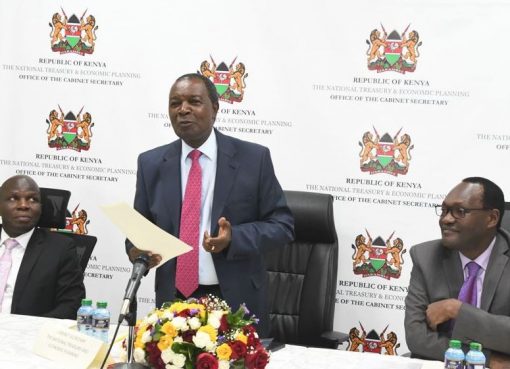Value Chain players in the milk industry are concerned that the current production is unable to sustain the growing demand for milk in the country.
The State department of Livestock Principal Secretary (PS), Harry Kimtai said milk consumption per person per year stand at 110 litres, an increase from 80 litres for the last decade.
The PS who was speaking during the launch of the Kenya Dairy industry annual award programe in Nairobi that aims to sustain growth within the multi-billion shilling sub sector, said Kenya has the highest consumption per capita followed closely by South Africa and Uganda at 90 litres and 60 litres respectively.
“The high consumption is being driven by an increased urbanization and growing middle class at the rate of 3 per cent but government is planning to increase the consumption to 220 litres per person per year in the next 11 years as outlined in the Vision 2030,” Kimtai said.
The Achievements in the sector, the PS noted, is due to the progressive leadership that has embraced new technologies and practices that promote greater efficiency and productivity and have continuously explored new paths in the growth.
The dairy industry contributes over four percent to the Gross Domestic Product (GDP), due to the increasing domestic milk production which averages 5.3 per cent per year and dairy processing capacity growing at 7 per cent per year.
Kimtai however, acknowledged that despite the growth, there are a number challenges that the industry is crumbling with such as low productivity per cow, inadequate extension, fluctuating milk production, low quality feeds, milk quality concerns, high cost of production, inefficiencies along the value chain and inadequate legal and regulatory framework.
The PS said that the Dairy Industry Bill which is in parliament will, if enacted, recognize milk from other milk producing species such Camels,Goats and Sheep and this is going to open up the industry in the semi and arid areas of Kenya where these species are majorly kept.
“As we launch this programme which is aimed at identifying and recognizing outstanding actors in the dairy value chain, I want to appreciate the significant efforts made by industry players to make the dairy Industry one of the most successful agricultural subsectors in Kenya,” he said.
He noted that the government is reworking on the Dairy Industry Licensing Regulations 2018 and has formed a new team with an expanded mandate to seek views from the stakeholders and come up with new regulations.
“The new regulations we hope will enhance order in the industry as well as inspire more growth,” he added.
Four months ago, when the regulations were published, a heated debate erupted among consumers, farmers and other players forcing Kenya Dairy Board (KDB) to withdraw them. The rules published provided that a person shall not sell, offer for sale or expose for consumption, any milk in raw form.
The new taskforce has been mandated to carry out extensive gathering of views from all the stakeholders, counties, dairy processors, breeders, dairy associations and dairy cooperative societies among other actors.
The annual award programme aims at identifying and rewarding excellent practices and performance by value chain players in input supply, milk and fodder production, milk bulking and aggregation, value addition and social inclusion.
Kimtai asked the judging panel who have been picked to carry out an objective assessment and ensure that winners will have demonstrated impressive leadership and creativity in the application of technology and other practices that enhance sustainable production, market access and protect our environment.
“Dairy farms and companies of all sizes should use sustainable practices because it is good for the environment, good for consumers and good for business.In addition also consider learning, innovation, scalability and replicability and if well implemented, these award-winning practices can serve as models for other farmers,’’ Kimtai said.
The Kenya Dairy Board (KDB) Managing Director, Margaret Kibogy said local farmers compared to their counterparts in other African countries are still paying high income in terms of farm gate price.
Last year the lowest payment that farmers received locally was Sh.28 per litre compared to Sh.18 in Uganda and thus the board fears that milk production is likely to be interrupted due to land diminishing, population increase, effects of climate change, low cow productivity and competition from other beverages.
Kibogy noted that the current annual production stands at 5.2 billion litres out of which 635 million was processed in 2018 production year an increase of 7.4 percent from 591 million litres in 2017.
Dairy is one of the fastest growing agricultural subsectors in Kenya providing a livelihood to over 1.8 million smallholder rural households.
The awards scheme, the first ever, is being sponsored by Centre for Agricultural and Rural Co-operation (CTA), East, Southern African Dairy Association (ESADA) and Kenya Dairy Board and will recognize the unique efforts by the different value chain actors that have led to the success of the industry especially at the stallholder level.
This annual award programme will identify and reward excellent practices and performance by value chain players in input supply, milk and fodder production, milk bulking and aggregation, value addition and social inclusion.
By Wangari Ndirangu



